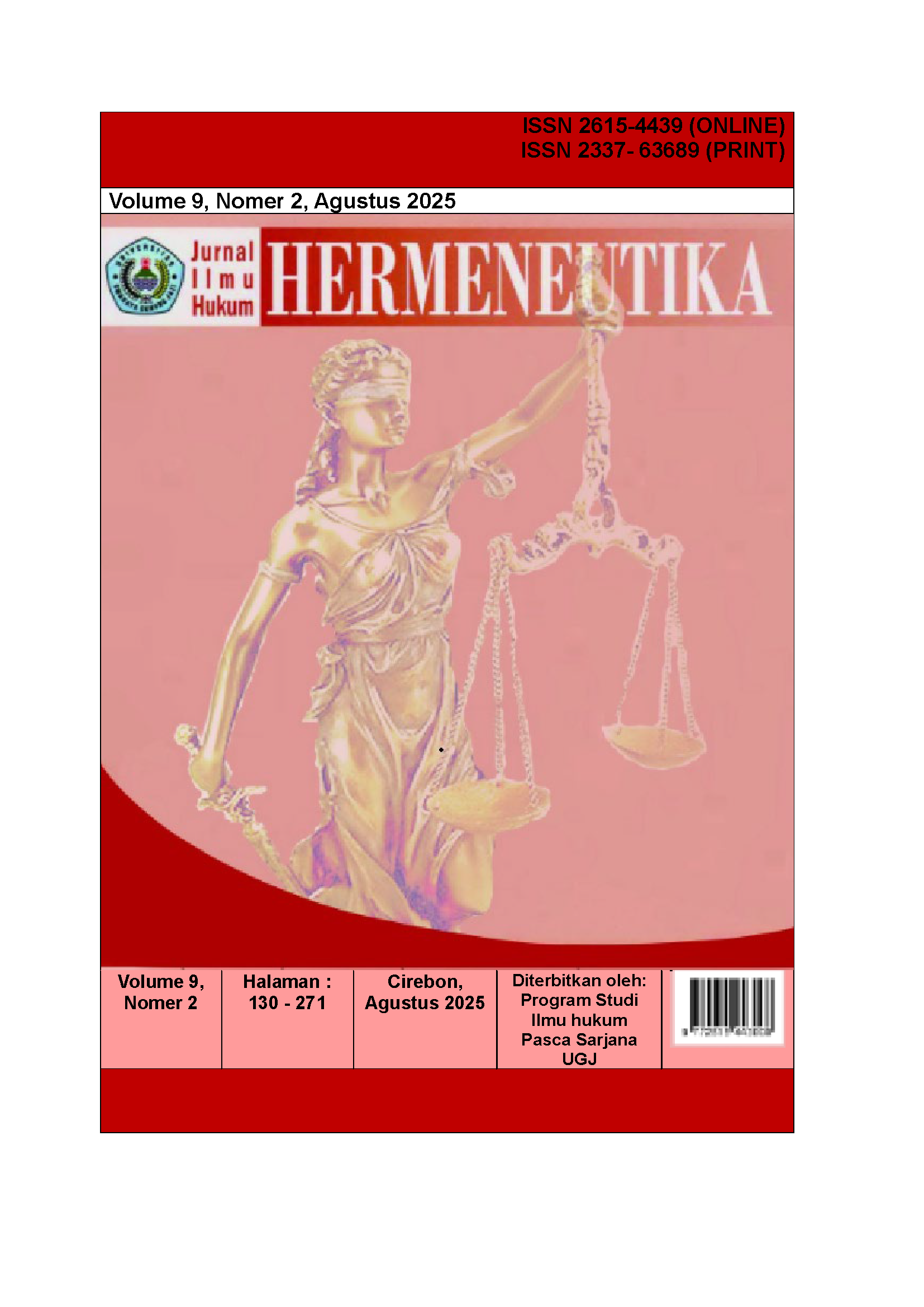THE EFFECTIVENESS OF ANTI-CORRUPTION POLICIES IN THE DIGITAL AGE: A LITERATURE REVIEW ON THE USE OF TECHNOLOGY IN THE ERADICATION OF CORRUPTION
DOI:
https://doi.org/10.33603/hermeneutika.v9i2.10043Kata Kunci:
Anti Corruption Policy, Digital Technology, Transparency, Institutional Reform, Infrastructure GapAbstrak
In Indonesia, corruption remains an important issue, which is reflected in the country's loss due to a 38 Corruption Perception Index (CPI) 2023 and 1.25 corruption incidents (2019-2023) of RP27 trillion rings. While traditional approaches are considered less effective, the digital age offers possibilities through technologies such as e-government, blockchain, and artificial intelligence (AI). The purpose of this study is to analyze the effectiveness of digital devices in anti-corruption guidelines and to identify the factors that support and hinder their implementation. Normative legal research methods have been employed in literature studies that analyze primary sources (legal documents and court decisions) and secondary sources (global case studies), and conduct comparative and historical analyses. The results of the study show that digital technology increases the obligation of transparency and accountability. E-Pro-Pro Cuceed reduced corruption in procurement supply by 0%. AI in Surveillance Information Systems (SIMPONI) reduced corruption cases by 28% (2020-2023), and blockchain was also demonstrated. However, its effectiveness is hampered by gaps in digital infrastructure, low literacy in equipment technology, and bureaucratic resistance. The study also corrects the over-optimism of isolated technology solutions by demonstrating the importance of integrating digital innovation with institutional reforms, such as the following. Political recommendations include increased training in digital capabilities, regulatory harmonization for technology adoption, and multilateral cooperation. The study confirms that a hybrid approach (a combination of technology and governance reform) is more effective in combating corruption than mere technical solutions. The theoretical implications modify the leading day theory by incorporating the digital dimension as a crucial variable.
Referensi
Azmi, I. F., & Nugroho, A. A. (2023). Sistem anti-korupsi 4.0: Adopsi teknologi blockchain di sektor publik. Integritas: Jurnal Antikorupsi, 9(1), 93–108. https://doi.org/10.32697/integritas.v9i1.985
Baza, M. R. M., & Agil, M. (2023). Peran penting teknologi digital blockchain dalam upaya mengurangi kasus korupsi penggelapan surat berharga. Jurnal Hukum dan Sosial Politik, 1(3), 43–54. https://doi.org/10.59581/jhsp-widyakarya.v1i1
Bhatnagar, S. (2015). E-government and anti-corruption: A case study of India. In L. Lawton & H. I. Sorby (Eds.), Combating corruption and fraud in the public sector (pp. 137–155). Edward Elgar Publishing.
Davis, F. D. (1989). Perceived usefulness, perceived ease of use, and user acceptance of information technology. MIS Quarterly, 13(3), 319–340. https://doi.org/10.2307/249008
Heeks, R. (2017). ICTs and anti-corruption: Theory and overview. Development Informatics Working Paper Series, 68.
Kadek Dini, A. W., & Maharani, I. G. A. S. R. (2023). Media sosial: Penyajian bukti digital tindak pidana korupsi dalam peradilan pidana di Indonesia. Jurnal Kertha Desa, 11(12), 3798–3810.
Kim, S., & Kim, H. J. (2020). Predictive analytics for anti-corruption in public procurement: A case study of South Korea. Government Information Quarterly, 37(4), 101487. https://doi.org/10.1016/j.giq.2020.101487
Klitgaard, R. (1988). Controlling corruption. University of California Press.
Komisi Pemberantasan Korupsi (KPK). (2021). Laporan investigasi kasus korupsi dana bansos COVID-19. https://kpk.go.id
Komisi Pemberantasan Korupsi (KPK). (2023). Statistik penindakan kasus korupsi 2019–2023. https://kpk.go.id
Harefa, A. (2020). Analisis Hukum Terhadap Penjatuhan Pidana di Bawah Ancaman Minimum Kepada Pelaku Tindak Pidana Korupsi. Journal Education and Development, 8(1), 434–439.
Unduhan
Diterbitkan
Terbitan
Bagian
Citation Check
Lisensi
Hak Cipta (c) 2025 rifdah rahmafillah, Ririn Yuliandari Aida Putri, Rika Sartika

Artikel ini berlisensiCreative Commons Attribution-ShareAlike 4.0 International License.
The Authors submitting a manuscript do so on the understanding that if accepted for publication, copyright of the article shall be assigned to Jurnal HERMENUTIKA, Sekolah Pascasarjana Ilmu Hukum. Universitas Swadaya Gunung Jati as publisher of the journal. Copyright encompasses rights to reproduce and deliver the article in all form and media, including reprints, photographs, microfilms, and any other similar reproductions, as well as translations.
Jurnal HERMENEUTIKA, Universitas Swadaya Gunung Jati and the Editors make every effort to ensure that no wrong or misleading data, opinions or statements be published in the journal. In any way, the contents of the articles and advertisements published in Jurnal HERMENEUTIKA are the sole responsibility of their respective authors and advertisers.










